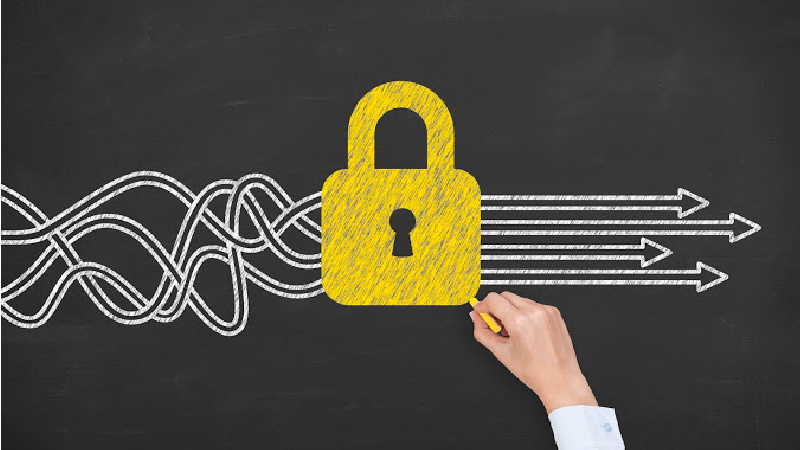Every year, we hear or read about massive data breaches that cost companies millions of money. Today, data is as valuable as currency. When it falls into the wrong hands, this information can use to exploit, extort or even blackmail innocent victims. These breaches have forced many organizations to divert their attention to online data security management.

In previous article we try to find how to avoid blockchain hacking. In this article, we are going to introduce you to data security management and some of the crucial aspects that revolve around it including technologies that can help secure data.
Enterprise Data Protection
The term Enterprise Data Protection refers to the process of delivering, monitoring, and managing data protection within all departments of an organization. This process involves the use of various tools and techniques to safeguard customer/user data from breaches.
Within a company, Enterprise Data Protection ensures data isn’t easily lost nor is it accessed by unauthorized personnel. This is achieved through the enforcement of strict policies and standards that have to be adhered to by the organization’s employees.
Below are key steps that can help an organization protect its data;
-
Identification of data available – The purpose of this step is to know which data is vulnerable and diverse ways on how to protect it better.
-
Data classification – Depending on the size of the organization, the data available may be too broad for the management to handle. Through classification, sensitive information can filter out and given more priority in terms of security.
-
Risk Management – Having classified sensitive data, it is up to the organization to manage and reduce the risk of such data.
-
Crafting a breach response – It is mandatory for a company to know what to do if their data gets breached. This is crucial as it minimizes the impacts of a data breach.
Data Security Management
Storage of data online is convenient, fast, saves up on space, and is relatively cost-effective. But it comes with a high risk of security breaches. Because most organizations nowadays opt to store data online, data security management has become a fundamental factor that requires a lot of attention.
Data security management entails the oversight of a company’s data so that it’s not accessed or corrupted by non-authorized persons. Management of data security requires planning, verification, and integration of systems that ensure the organization’s data is in safe hands.
It should involve the following aspects;
-
Creation of backups so that data isn’t lost
-
Encryption of data to make it inaccessible when transferred or stored online
-
Erasing of information when the device discarded or sold
-
Masking of data to hide sensitive information
-
Authentication through the use of passwords and usernames
-
Usage of electronic security tokens (commonly used on physical devices storing digital data)
Data security management is a lengthy and complex process that involves everyone within the organization. Obviously, there must be certain individuals who will task to oversee this process and ensure information is kept safe. To make this possible, certain data security technologies have to be used.

Data Security Technologies
Living in an era where data breaches are so rampant, technology plays a key role in leveling out the battlefield. The following data security technologies make it harder for information to be lost or accessed by unauthorized people.
-
Cloud data protection – Nowadays, when you work with the likes of Symantec or Cisco, you get both cloud storage and high-end encryption to secure your data.
-
Tokenization – This cutting edge technology substitutes sensitive data for a randomly generated value, thus making it harder for hackers to access the original file.
-
Data access governance – When data volumes increase, there arises the need for cleaning up and discovery of new sensitive information while managing permissions and access. This is what data access governance can do for you.
-
Data discovery and flow mapping – This new technology allows management to scan new data and classify according to sensitivity.
Other data security technologies include; application-level encryption and enterprise key management.

Data Security Threats
Having talked much about data security management and protection, what are some of these threats that we are protecting it from?
-
Public Wi-Fi access – This is the biggest data security threat today. We all love free things. When you are at the airport or coffee shop, you may tempt to engage in some light ‘out of the office’ work. This puts you at a high risk of giving away sensitive information because you connected to an unsecured network.
-
Shoulder surfing – This refers to when a hacker peers over your shoulder to obtain data from your phone or laptop. This can happen anywhere even at the office. Employees who tasks by an organization to handle sensitive details should be aware of their surroundings and prevent this threat from exposing data.
-
Malware – Thanks to antivirus software, this is no longer a major threat. However, spyware and viruses expose your phone or laptop to cyber criminals who can gain access to data.
-
Phishing scams – This threat comes in the form of a link or website that asks for your details and uses them to access your data.
There are lots of data security threats out there. And new ones keep on being invented every day. As an internet user, you should be well-versed with the threats that exist out there and know how to avoid them.

Types of Security Breaches
Knowing the different types of data breaches that exist is important in helping prevention of such scenarios as well as devising ways on dealing with them (if they do occur). Types of security breaches:
-
Physical Breach – This happens when a laptop, smartphone, or hard drive stolen and it happens to contain sensitive data. Hackers then break into the device and look for data. This can avoid by setting up strong passwords and using technology that allows you to remotely factory reset the device.
-
Electronic Breach – It involves the unauthorized entry on a network or system where data stored. Electronic breaches did through phishing or the use of malware. Encryption is the best way to prevent this type of breach.
Final Thoughts
It’s not just organizations that can benefit from data security management but so can everyone. Information is very important and you need to ensure it is secure. Finally, through the identification of data security threats and using the latest technologies, you can manage and safeguard sensitive information from cyber criminals.




